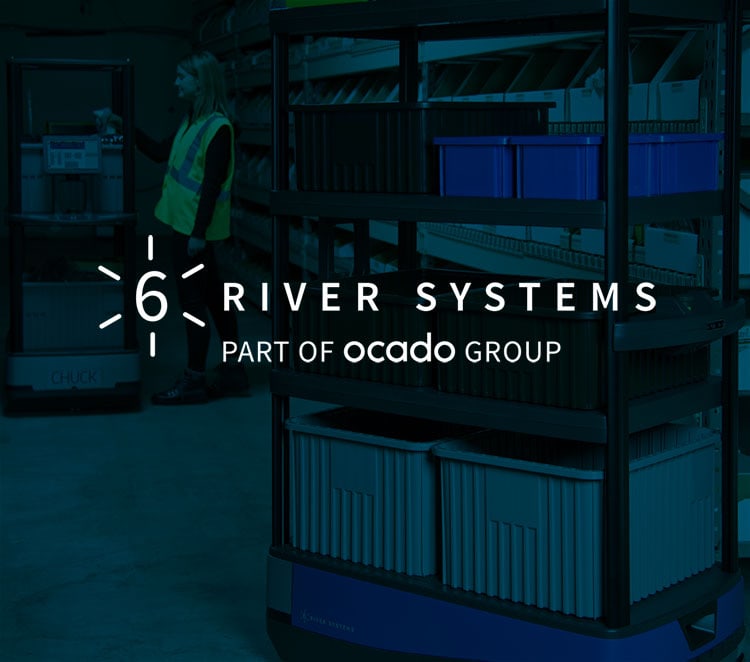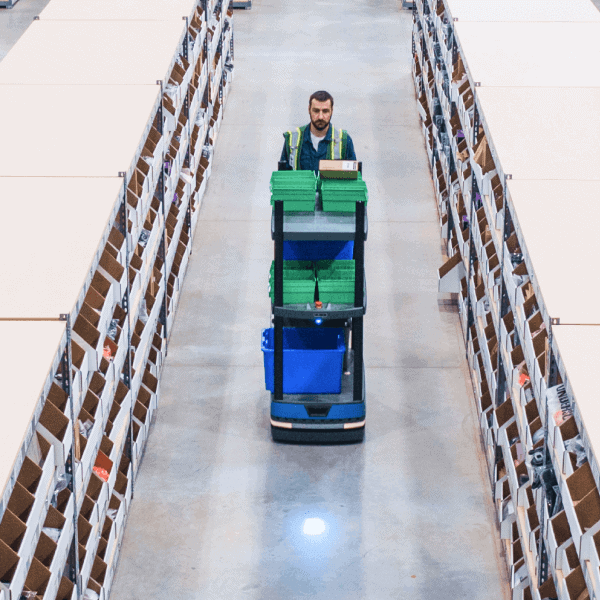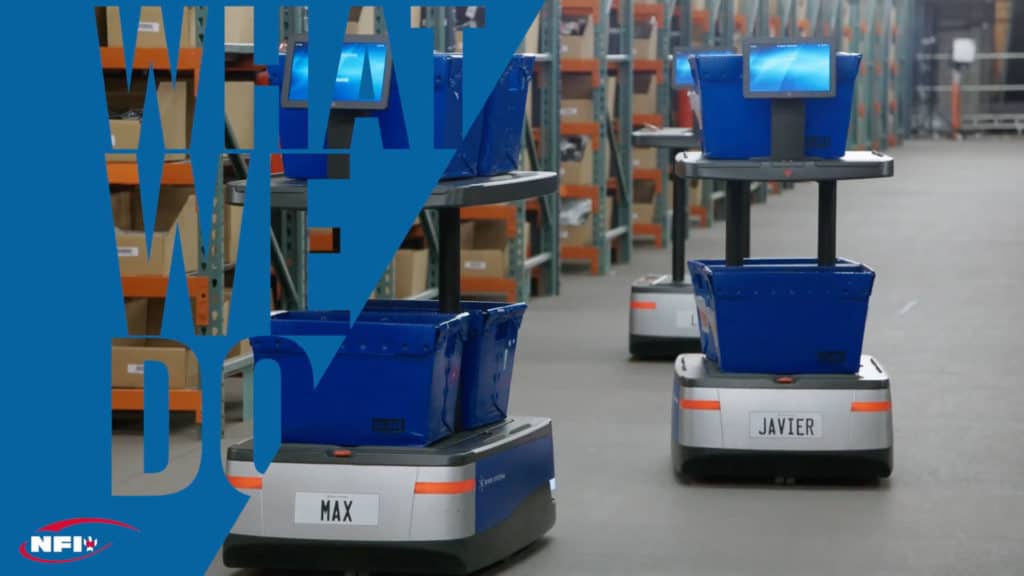Pick and place robots are commonly used in modern manufacturing environments. Pick and place automation speeds up the process of picking up parts or items and placing them in other locations. Automating this process helps to increase production rates. Pick and place robots handle repetitive tasks while freeing up human workers to focus on more complex work.
How pick and place robots work
Typically mounted on a stable stand, pick and place robots are positioned to reach different areas to perform work. They use advanced vision systems to identify, grasp and move objects from one place to another. With a variety of design options available, pick and place robots can be configured with various end-of-arm tooling options for use in different applications, such as assembly, packaging or bin picking. For example, pick and place robot systems may be used to pick up items for an order and place them in a box for packaging, or they may be used to pick up parts needed for assembly and move them to the next location.
Types of pick and place robots
There are several pick and place robot types and components, including:
- Robotic arm – Robotic arms are the most common type of pick and place robots. A 5-axis robotic arm robot can be used for standard pick and place applications where objects are picked up and moved to other locations in a single plane. A 6-axis robotic arm robot is used for more complex applications, such as when objects must be twisted or re-oriented before being placed in another location.
- Cartesian – Like a 6-axis robotic arm, Cartesian robots work in multiple planes. These robots move in three orthogonal axes (X, Y and Z) using Cartesian coordinates. They can be constructed with any type of linear actuator and several types of drive mechanisms such as belt, ball or lead screw mechanisms. They typically have better positioning accuracy compared to 6-axis robotic arms.
- Delta – Often used in applications where robots pick items in groups and place them in assembly patterns or containers, Delta robots have advanced vision technologies that enable them to distinguish various sizes, shapes and colors. There are several configurations of Delta robots, but most have three arms that operate on four axes. They have heavy motors affixed to a frame, with lightweight arms connected to linking rods with joints at either end of each arm (typically ball joints) to allow movement.
- Fast pick – Fast pick robots are ideal for use in medium- and high-volume applications with high-velocity SKUs. Fast pick robots fully automate the picking process, freeing up the human workforce to focus on higher-impact activities. They’re ideal for fast-moving “top-off” items, such as promotional items added to orders or batteries. These robots can pick up to 300 SKUs per hour from a pool of up to 8 SKUs.
- Collaborative – Collaborative robots augment the work of humans by leading associates to pick locations and guiding associates through each task. By optimizing routes in real-time and keeping associates on task, collaborative robots help associates work more efficiently.

Applications for pick and place robots
Pick and place robots are often used in manufacturing but are also used in applications such as packaging, bin picking and inspection. Here’s a look at a few of the most common applications for pick and place robots and how they’re used.
- Assembly – Pick and place robots used in assembly applications grab incoming parts from one location, such as a conveyor, and place or affix the part on another piece of the item. The two joined parts are then transported to the next assembly area.
- Packaging – Pick and place robots used in the packaging process grab items from an incoming source or designated area and place the items in a packaging container.
- Bin picking – Pick and place robots used in bin picking applications grab parts or items from bins. These pick and place robots typically have advanced vision systems allowing them to distinguish color, shape and size to pick the right items even from bins containing randomly mixed items. These parts or items are then sent to another location for assembly or packaging.
- Inspection – Pick and place robots used for inspection applications are equipped with advanced vision systems to pick up objects, detect anomalies and remove defective parts or items by placing them in a designated location.
Benefits of pick and place robots
The primary benefits of pick and place robots are speed and consistency. Robots can be customized to meet specific production requirements, and they’re easily programmable so they can be used for multiple applications. While designs vary, pick and place robots are often small in size and lightweight, making them ideal for use in applications where space is limited.
Small pick and place robots help to increase output, aiding with the order picking and packaging processes in warehouse settings. They also provide good ROI to manufacturers. In both settings, pick and place robots relieve associates and operators of monotonous, repetitive work, which boosts productivity while alleviating the physical strain on human workers that commonly results from performing these types of tasks.
How to choose the right pick and place robot
Pick and place robots can execute virtually all material handling operations both cost-efficiently and effectively — whether it’s parts assembly, bin picking or packaging applications. With several designs and configurations available in the market, it can be challenging to pick one that suits your operational needs. To help you make the right decision, let’s review some factors and features you should look out for when purchasing a pick and place robot.
Number of Axes
The number of axes determines the degree of freedom and movement of the pick and place robot. Generally, more axes mean more movement and flexibility, so it’s best to have more axes than less. For order fulfillment applications of robots in which items are placed onto a conveyor, picking bin or directly into a packaging container, the robot should come with four to five axes. Six or more axes are preferable for applications in which the robot needs to rotate or move linearly to handle tasks within its work envelope.
Reach
Reach is part of the work envelope that describes the maximum distance (horizontal and vertical) within which a pick and place robot can handle items. Since the robot must pick and place items with high precision, you should evaluate its reach to determine if it’s suitable for your operations. The maximum horizontal reach is the distance from the center of the robot base to the farthest point of its gripper or custom end of arm tool. The maximum vertical reach for a robot is measured from the lowest point that the robot can reach (usually its base) to the maximum height the wrist can go.
Repeatability
Repeatability describes a robot’s ability to pick and drop items at the exact same position for each routine it completes. High precision activities (such as building an electronic circuit board) require robots with excellent repeatability and a zero-tolerance radius. The right pick and place robot should be able to meet the tolerance radius for your target application — approximately (< 0.5mm) for order fulfillment operations.
Speed
To improve productivity and efficiency, you’ll need a pick and place robot that can consistently complete your material handling operations at the required speed. A robot’s spec sheet usually indicates a speed (in degrees per second) ranging from 0 to the maximum speed. Ensure that the pick and place robot can perform operations at (and above) the speed your operation requires. Also, it’s best to purchase a pick and place robot with a maximum speed that can comfortably handle peak demand periods.
Configuration and vision
Pick and place robots can be:
- An articulate or scara robot (fixed with rotary arms on three vertical axes)
- A spherical robot providing and one linear and two rotational movements
- A cylindrical robot providing movement in horizontal, vertical and rotational axes
While most pick and place robots are flexible, they are constrained by their dimensions, product-handling nozzles and latitude of movement. These characteristics affect where they can be deployed and the items they can handle. Also, the vision guidance system should be sophisticated enough to identify several items from a pool of SKUs.
Payload
The payload is the maximum weight the robot can transfer from one point to another. It includes the weight of the product being picked and the weight of the robot’s end of arm tooling. A pick and place robot must be able to lift the heaviest item in your inventory and fully extend its arm and place said item precisely.
How much do pick and place robots cost?
Logistics operators can benefit immensely from deploying the right pick and place robots in their warehouses. With the coronavirus pandemic disrupting supply chains around the globe, it’s more important than ever for businesses to automate order fulfillment activities to keep pace with rising consumer demands and a declining labor supply.
Pick and place robots execute pick tasks precisely, accurately and reliably — without taking breaks or being susceptible to fatigue, monotony and environmental distractions. While such automated precision should come with a hefty price tag, estimates put the upfront cost of a pick and place robot at a few thousand dollars.
Installation time is negligible since businesses don’t need to make major infrastructure changes to their warehouse space. The right pick and place robots can begin operating almost as soon as they’ve been installed and programmed and can start improving productivity levels immediately.
Despite the level of sophisticated technology used in building pick and place robots, they require minimal maintenance. Using the proper cleaning techniques and maintenance guidelines, businesses can do all the required maintenance in-house. This makes the total cost of ownership of a pick and place robot much lower than other warehouse automation technologies.
Investing in pick and place robots enables companies to gain a competitive edge and maximize the productivity of their facilities.
Learn more about Fast Lane by 6 River Systems, a fully automated picking solution for high-velocity SKUs. Interested in more? Let’s discuss the solution that’s right for you. Contact us today.


